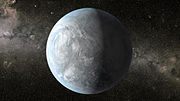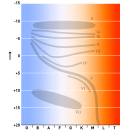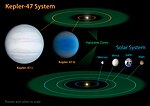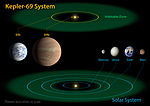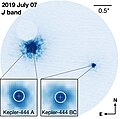Kepler-36 is a star in the constellation of Cygnus with two known planets. It has an anomalously large radius, meaning that it is a subgiant. On June...
6 KB (353 words) - 17:50, 3 May 2024
Johannes Kepler (/ˈkɛplər/; German: [joˈhanəs ˈkɛplɐ, -nɛs -] ; 27 December 1571 – 15 November 1630) was a German astronomer, mathematician, astrologer...
102 KB (12,606 words) - 13:37, 19 October 2024
Kepler-22b (also known by its Kepler Object of Interest designation KOI-087.01) is an exoplanet orbiting within the habitable zone of the Sun-like star...
19 KB (1,838 words) - 18:02, 30 July 2024
The Kepler conjecture, named after the 17th-century mathematician and astronomer Johannes Kepler, is a mathematical theorem about sphere packing in three-dimensional...
22 KB (2,700 words) - 01:20, 19 August 2024
Kepler-186f (also known by its Kepler object of interest designation KOI-571.05) is an Earth-sized exoplanet orbiting within the habitable zone of the...
32 KB (3,103 words) - 14:39, 23 August 2024
Kepler-90, also designated 2MASS J18574403+4918185, is a F-type star located about 2,790 light-years (855 pc) from Earth in the constellation of Draco...
19 KB (1,757 words) - 15:22, 4 September 2024
Kepler-36b is an exoplanet orbiting the star Kepler-36. This planet has the closest conjunction to Kepler-36c every 97 days. Its density is similar to...
4 KB (213 words) - 00:11, 27 September 2023
List of multiplanetary systems (redirect from Kepler-55)
with the most confirmed planets are the Sun (the Solar System's star) and Kepler-90, with 8 confirmed planets each, followed by TRAPPIST-1 with 7 planets...
263 KB (8,775 words) - 15:54, 5 October 2024
In geometry, a Kepler–Poinsot polyhedron is any of four regular star polyhedra. They may be obtained by stellating the regular convex dodecahedron and...
31 KB (2,312 words) - 14:56, 29 July 2024
Kepler-442b (also known by its Kepler object of interest designation KOI-4742.01) is a confirmed near-Earth-sized exoplanet, likely rocky, orbiting within...
18 KB (1,781 words) - 23:38, 25 May 2024
provided. Kepler-29 has a pair of planets in a 7:9 resonance (ratio of 1/1.28587). Kepler-36 has a pair of planets close to a 6:7 resonance. Kepler-37 d,...
97 KB (10,257 words) - 06:27, 11 October 2024
Kepler-62 is a K-type main sequence star cooler and smaller than the Sun, located roughly 980 light-years (300 parsecs) from Earth in the constellation...
17 KB (1,612 words) - 05:28, 23 August 2024
Kepler-62e (also known by its Kepler Object of Interest designation KOI-701.03) is a super-Earth exoplanet (extrasolar planet) discovered orbiting within...
15 KB (1,400 words) - 21:00, 6 October 2024
crossing Planets in orbit around subgiant stars include Kappa Andromedae b, Kepler-36 b and c, TOI-4603 b and HD 224693 b. Sandage, Allan; Lubin, Lori M.; Vandenberg...
29 KB (3,704 words) - 14:29, 1 October 2024
Kepler-62f (also known by its Kepler Object of Interest designation KOI-701.04) is a super-Earth exoplanet orbiting within the habitable zone of the star...
24 KB (2,434 words) - 03:25, 11 September 2024
Kepler-47b (also known as Kepler-47 (AB) b and by its Kepler Object of Interest designation KOI-3154.01) is an exoplanet orbiting the binary star system...
9 KB (749 words) - 08:45, 10 April 2024
Maximilian Kepler-Różycki (born February 10, 1993) is a German-American professional baseball outfielder for the Minnesota Twins of Major League Baseball...
25 KB (2,451 words) - 18:09, 6 October 2024
List of stars in Cygnus (redirect from Kepler-533)
Dennis; Zhou, Yixiao; White, Timothy R. (2020), "Asteroseismology of 36 Kepler subgiants – I. Oscillation frequencies, linewidths, and amplitudes", Monthly...
64 KB (298 words) - 11:02, 22 August 2024
Kepler-47c (also known as Kepler-47(AB)-c and by its Kepler Object of Interest designation KOI-3154.02) is an exoplanet orbiting the binary star system...
15 KB (1,416 words) - 05:27, 23 August 2024
Kepler-69c (also known by its Kepler Object of Interest designation KOI-172.02) is a confirmed super-Earth extrasolar planet, likely rocky, orbiting the...
14 KB (1,209 words) - 23:16, 5 June 2024
Kepler-1544b is a potentially habitable (optimistic sample) exoplanet announced in 2016 and located 1138 light years away, in the constellation of Cygnus...
5 KB (299 words) - 11:04, 16 June 2024
In celestial mechanics, a Kepler orbit (or Keplerian orbit, named after the German astronomer Johannes Kepler) is the motion of one body relative to another...
42 KB (5,982 words) - 18:04, 20 December 2023
universe), approximately 119 light-years (36 pc) away from Earth in the constellation Lyra. On 27 January 2015, the Kepler spacecraft is reported to have confirmed...
21 KB (1,394 words) - 05:27, 23 August 2024
ISSN 1538-3881. "Exoplanet-catalog-Exoplanet exploration-Kepler-1606b". Specht, D.; et al. (2023). "Kepler K2Campaign 9 – II. First space-based discovery of...
80 KB (5,087 words) - 12:09, 17 October 2024
Kepler-1649c is an Earth-sized exoplanet, likely rocky, orbiting within the habitable zone of the red dwarf star Kepler-1649, the outermost planet of...
10 KB (885 words) - 21:09, 14 January 2024
This is a partial list of exoplanets discovered by the Kepler space telescope, running from star number 1 through 500, inclusive. All lists: 1–500 501–1000...
170 KB (2,916 words) - 06:55, 29 June 2024
Kepler-186 is a main-sequence M1-type dwarf star, located 177.5 parsecs (579 light years) away in the constellation of Cygnus. The star is slightly cooler...
17 KB (1,540 words) - 14:41, 23 August 2024
Kepler-452 is a G-type main-sequence star located about 1,810 light-years away from Earth in the Cygnus constellation. Although similar in temperature...
13 KB (1,189 words) - 08:01, 9 May 2024
proven a false positive by NASA in 2015. Several other KOIs, like Kepler-577b and Kepler-1649b, were considered potentially habitable prior to confirmation...
57 KB (3,065 words) - 18:15, 17 October 2024
Kepler-22 is a Sun-like star in the northern constellation of Cygnus, the swan, that is orbited by 1 planet found to be unequivocally within the star's...
10 KB (659 words) - 21:55, 24 August 2024










